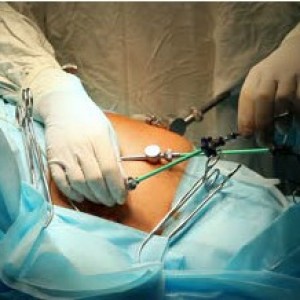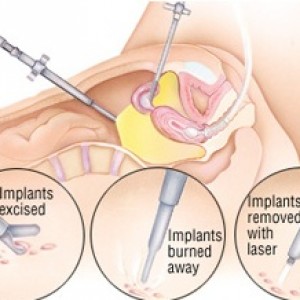What is a laparoscopy?
 Laparoscopy is a procedure to look inside your abdomen by using a laparoscope. A laparoscope is like a thin telescope with a light source. It is used to light up and magnify the structures inside the abdomen. A laparoscope is passed into the abdomen through a small incision (cut) in the skin.
Laparoscopy is a procedure to look inside your abdomen by using a laparoscope. A laparoscope is like a thin telescope with a light source. It is used to light up and magnify the structures inside the abdomen. A laparoscope is passed into the abdomen through a small incision (cut) in the skin.
A laparoscopy may be done to find the cause of symptoms such as abdominal pain, pelvic pain, or swelling of the abdomen or pelvic region. Or, it may be done if a previous test such as an X-ray or scan has identified a problem within the abdomen or pelvis. A laparoscopy enables a doctor to see clearly inside your abdomen. Some common conditions which can be seen by laparoscopy include:
- Endometriosis
- Pelvic inflammatory disease
- Ectopic pregnancy
- Ovarian cyst
- Appendicitis
What is laparoscopic surgery?
In addition simply to looking inside, a doctor can use fine instruments which are also passed into the abdomen through another small incision in the skin. These instruments are used to cut, trim, biopsy, grab, etc, inside the abdomen. This laparoscopic surgery is sometimes called ‘keyhole surgery’ or ‘minimally invasive surgery’. Laparoscopic surgery can be used for various procedures.
Some commonly performed operations include:
- Removal of the gallbladder. This is sometimes called a laparoscopic cholecystectomy, or ‘lap choly’ for short. It is now the most common way for a gallbladder to be removed.
- Removal of the appendix.
- Removal of patches of endometriosis.
- Removal of parts of the intestines.
- Female sterilisation.
- Treating ectopic pregnancy.
- Taking a biopsy (small sample) of various structures inside the abdomen which can be looked at under the microscope and/or tested in other ways.
In general, compared with traditional surgery, with laparoscopic surgery there is usually:
- Less pain following the procedure.
- Less risk of complications.
- A shorter hospital stay and a quicker recovery.
- A much smaller scar.
How is it done?
Laparoscopy and laparoscopic surgery are usually done whilst you are asleep under general anaesthesia. The skin over the abdomen is cleaned. The surgeon or gynaecologist then makes a small incision (cut) about 1-2 cm long near to the navel (belly button). Some gas is injected through the cut to ‘blow out’ the abdominal wall slightly. This makes it easier to see the internal organs with the laparoscope which is gently pushed through the incision into the abdominal cavity. The surgeon or gynaecologist then looks down the laparoscope or looks at pictures on a TV monitor connected to the laparoscope.
 If you have a surgical procedure, one or more separate small incisions are made in the abdominal skin. These allow thin instruments to be pushed into the abdominal cavity. The surgeon or gynaecologist can see the ends of these instruments with the laparoscope and so can perform the required procedure.
If you have a surgical procedure, one or more separate small incisions are made in the abdominal skin. These allow thin instruments to be pushed into the abdominal cavity. The surgeon or gynaecologist can see the ends of these instruments with the laparoscope and so can perform the required procedure.
When the surgeon or gynaecologist has finished, the laparoscope and other instruments are removed. The incisions are stitched and dressings are applied.
What preparation do I need to do?
As you will usually be under a general anaesthetic, your hospital should give you instructions about fasting before the operation. Depending on the reason for your operation, there may be more specific instructions. Your doctor will give you this information if necessary.
After a laparoscopy?
You may feel a little sore around the incisions. You may have some pain in your shoulder tip. This is caused by the gas which had been pumped inside irritating the diaphragm which has the same nerve supply as the shoulder tip. This pain soon passes off. The length of time to recover can vary, depending on why the procedure was done and what operations were performed.
Are there any possible complications from a laparoscopy?
There may be some minor bleeding or bruising around the skin incisions. Otherwise, in most cases a laparoscopy just to look inside goes without any problem. Possible problems which may occur include the following:
- Accidental damage to structures inside the abdomen, such as the intestines or certain blood vessels. This is rare but, if it occurs, an emergency traditional operation may be needed to correct the damage.
- As with any operation, there is a small risk of complications of anaesthesia.
- Occasionally, the incision becomes infected which may require a course of antibiotics.
